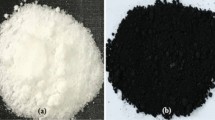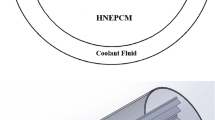Abstract
Conventional surfactants such as CTAB (cetrimonium bromide), SDS (sodium dodecyl sulphate), SDBS (sodium dodecyl sulphonate) are combined with nanofluids to improve the stability and thermal conductivity of nanofluids. These nanofluids are mainly used for heat transfer applications where heating and cooling are usual courses of action which result in surfactants producing foams and polluting the heat transfer media, affecting the total system performance. Besides, the common surfactant molecules that augment the thermal resistance between the nanoparticles and base fluid also affect the thermophysical properties of the nanofluid. In this paper, [Bmim][Cl] (1-butyl-3-methylimidazolium chloride), a high purity ionic liquid (IL) with higher thermal stability was used to provide a comparative study on the stability and thermal properties with that of the conventional surfactants (CTAB, SDS, SDBS) on multiwalled carbon nanotubes (MWCNT)/propylene glycol (PG) nanofluid. The transient hot-wire based KD2-Pro and zeta potential results demonstrated that the inclusion of ionic liquid improved the thermal conductivity and stability of the formulated nanofluid. However, much like the conventional surfactants, the strong electrostatic repulsive force created by the ionic liquid was found to decrease when the temperature is increased. The outcome demonstrated the most extreme thermal conductivity upgrade of 33.7% at 303 K and maximum dispersion stability of more than one month without any aggregation for the nanofluid containing ionic liquid.














Similar content being viewed by others
Abbreviations
- Al2O3 :
-
Aluminium oxide
- Au:
-
Gold
- BmimCl:
-
1-Butyl-3-methylimidazolium chloride
- CTAB:
-
Cetrimonium bromide
- EDX:
-
Energy-dispersive X-ray
- FESEM:
-
Field emission scanning electron microscope
- OD:
-
Outer diameter of MWCNTs
- FTIR:
-
Fourier transform infrared spectroscope
- h :
-
Heat transfer coefficient (W m−2 K−1)
- IL:
-
Ionic liquid
- INF:
-
Nanofluid containing ionic liquid
- k :
-
Thermal conductivity (W m−2 K−1)
- LiNO3 :
-
Lithium nitrate
- MWCNT:
-
Multiwalled carbon nanotubes
- PG:
-
Propylene glycol
- S1:
-
MWCNT + PG + SDS
- S2:
-
MWCNT + PG + SDBS
- S3:
-
MWCNT + PG + CTAB
- S4:
-
MWCNT + PG + IL
- SDBS:
-
Sodium dodecyl benzene sulphonate
- SDS:
-
Sodium dodecyl sulphate
- T :
-
Temperature (K)
- mass:
-
M (gram)
- ID:
-
Inner diameter of MWCNTs
- μ :
-
Dynamic viscosity (kg m−1 s−1)
- ρ :
-
Density (kg m−3)
- Ø :
-
Mass concentration (%)
- Cp:
-
Specific heat capacity (kJ kg−1 K−1)
- nf:
-
Nanofluid
- np:
-
Nanoparticle
- bf:
-
Base fluid
References
Moradi A, Toghraie D, Isfahani AHM, Hosseinian A. An experimental study on MWCNT–water nanofluids flow and heat transfer in double-pipe heat exchanger using porous media. J Therm Anal Calorim. 2019;137:1797–807. https://doi.org/10.1007/s10973-019-08076-0.
Ilyas SU, Pendyala R, Narahari M. Experimental investigation of natural convection heat transfer characteristics in MWCNT-thermal oil nanofluid. J Therm Anal Calorim. 2019;135:1197–209. https://doi.org/10.1007/s10973-018-7546-7.
Mukesh Kumar PC, Chandrasekar M. Heat transfer and friction factor analysis of MWCNT nanofluids in double helically coiled tube heat exchanger. J Therm Anal Calorim. 2020. https://doi.org/10.1007/s10973-020-09444-x.
Das PK, Mallik AK, Ganguly R, Santra AK. Stability and thermophysical measurements of TiO2 (anatase) nanofluids with different surfactants. J Mol Liq. 2018;254:98–107.
Choi TJ, Jang SP, Kedzierski MA. Effect of surfactants on the stability and solar thermal absorption characteristics of water-based nanofluids with multi-walled carbon nanotubes. Int J Heat Mass Transf. 2018;122:483–90.
Minea AA, Murshed SMS. A review on development of ionic liquid based nanofluids and their heat transfer behavior. Renew Sustain Energy Rev. 2018;91:584–99.
Shevelyova MP, Paulechka YU, Kabo GJ, Blokhin AV, Kabo AG, Gubarevich TM. Physicochemical properties of imidazolium-based ionic nanofluids: density, heat capacity, and enthalpy of formation. J Phys Chem C. 2013;117:4782–90. https://doi.org/10.1021/jp3059432.
de Castro CAN, Langa E, Morais AL, Lopes MLM, Lourenço MJV, Santos FJV, et al. Studies on the density, heat capacity, surface tension and infinite dilution diffusion with the ionic liquids [C4mim][NTf2], [C4mim][dca], [C2mim][EtOSO3] and [Aliquat][dca]. Fluid Phase Equilib. 2010;294:157–79.
Al-Waeli AHA, Chaichan MT, Kazem HA, Sopian K. Evaluation and analysis of nanofluid and surfactant impact on photovoltaic-thermal systems. Case Stud Therm Eng. 2019;13:100392.
Paul TC, Mahamud R, Khan JA. Multiphase modeling approach for ionic liquids (ILs) based nanofluids: improving the performance of heat transfer fluids (HTFs). Appl Therm Eng. 2019;149:165–72.
Oster K, Hardacre C, Jacquemin J, Ribeiro APC, Elsinawi A. Understanding the heat capacity enhancement in ionic liquid-based nanofluids (ionanofluids). J Mol Liq. 2018;253:326–39.
Wang B, Wang X, Lou W, Hao J. Ionic liquid-based stable nanofluids containing gold nanoparticles. J Colloid Interface Sci. 2011;362:5–14.
Liu J, Wang F, Zhang L, Fang X, Zhang Z. Thermodynamic properties and thermal stability of ionic liquid-based nanofluids containing graphene as advanced heat transfer fluids for medium-to-high-temperature applications. Renew Energy. 2014;63:519–23.
Xie H, Zhao Z, Zhao J, Gao H. Measurement of thermal conductivity, viscosity and density of ionic liquid [EMIM][DEP]-based nanofluids. Chin J Chem Eng. 2016;24:331–8.
Luo C, Li Y, Li N, Wang Y, Su Q. Thermophysical properties of lithium nitrate + 1-ethyl-3-methylimidazolium diethylphosphate + water system. J Chem Thermodyn. 2018;126:160–70.
Zhai Y, Li L, Wang J, Li Z. Evaluation of surfactant on stability and thermal performance of Al2O3-ethylene glycol (EG) nanofluids. Powder Technol. 2019;343:215–24.
Akhgar A, Toghraie D. An experimental study on the stability and thermal conductivity of water-ethylene glycol/TiO2-MWCNTs hybrid nanofluid: developing a new correlation. Powder Technol. 2018;338:806–18.
Chen W, Zou C, Li X. An investigation into the thermophysical and optical properties of SiC/ionic liquid nanofluid for direct absorption solar collector. Sol Energy Mater Sol Cells. 2017;163:157–63.
Sánchez-Coronilla A, Martín EI, Navas J, Aguilar T, Gómez-Villarejo R, Alcántara R, et al. Experimental and theoretical analysis of NiO nanofluids in presence of surfactants. J Mol Liq. 2018;252:211–7.
Gao T, Li C, Zhang Y, Yang M, Jia D, Jin T, et al. Dispersing mechanism and tribological performance of vegetable oil-based CNT nanofluids with different surfactants. Tribol Int. 2019;131:51–63.
Jin J, Li X, Geng J, Jing D. Insights into the complex interaction between hydrophilic nanoparticles and ionic surfactants at the liquid/air interface. Phys Chem Chem Phys. 2018;20:15223–35. https://doi.org/10.1039/C8CP01838C.
Albert J, Müller K. A group contribution method for the thermal properties of ionic liquids. Ind Eng Chem Res. 2014;53:17522–6. https://doi.org/10.1021/ie503366p.
Yunus NM, Abdul Mutalib MI, Man Z, Bustam MA, Murugesan T. Thermophysical properties of 1-alkylpyridinum bis(trifluoromethylsulfonyl)imide ionic liquids. J Chem Thermodyn. 2010;42:491–5.
Kurnia KA, Quental MV, Santos LMNBF, Freire MG, Coutinho JAP. Mutual solubilities between water and non-aromatic sulfonium-{,} ammonium- and phosphonium-hydrophobic ionic liquids. Phys Chem Chem Phys. 2015;17:4569–77. https://doi.org/10.1039/C4CP05339G.
Ziyada AK, Wilfred CD, Bustam MA, Man Z, Murugesan T. Thermophysical properties of 1-propyronitrile-3-alkylimidazolium bromide ionic liquids at temperatures from (293.15 to 353.15) K. J Chem Eng Data. 2010;55:3886–90. https://doi.org/10.1021/je901050v.
Kotov N, Raus V, Dybal J. Non-covalent interactions in bmimCl/co-solvent mixtures: a FTIR spectroscopy and computational study. J Mol Liq. 2019;285:688–96.
Bakthavatchalam B, Habib K, Saidur R, Shahabuddin S, Saha BB. Influence of solvents on the enhancement of thermophysical properties and stability of MWCNT nanofluid. Nanotechnology. 2020;31:235402.
Miranda A, Barekar N, McKay BJ. MWCNTs and their use in Al-MMCs for ultra-high thermal conductivity applications: a review. J Alloys Compd. 2019;774:820–40.
Xian HW, Sidik NAC, Saidur R. Impact of different surfactants and ultrasonication time on the stability and thermophysical properties of hybrid nanofluids. Int Commun Heat Mass Transf. 2020;110:104389.
Li X, Zeng G, Lei X. The stability, optical properties and solar-thermal conversion performance of SiC–MWCNTs hybrid nanofluids for the direct absorption solar collector (DASC) application. Sol Energy Mater Sol Cells. 2020;206:110323.
Bakthavatchalam B, Habib K, Saidur R, Saha BB, Irshad K. Comprehensive study on nanofluid and ionanofluid for heat transfer enhancement: a review on current and future perspective. J Mol Liq. 2020;305:112787.
Azarfar S, Movahedirad S, Sarbanha AA, Norouzbeigi R, Beigzadeh B. Low cost and new design of transient hot-wire technique for the thermal conductivity measurement of fluids. Appl Therm Eng. 2016;105:142–50.
Sezer N, Koç M. Stabilization of the aqueous dispersion of carbon nanotubes using different approaches. Therm Sci Eng Prog. 2018;8:411–7.
Kakavandi A, Akbari M. Experimental investigation of thermal conductivity of nanofluids containing of hybrid nanoparticles suspended in binary base fluids and propose a new correlation. Int J Heat Mass Transf. 2018;124:742–51.
Yellapu G, Vishal CVC, Kandoth MP, Saha P, Bojja RR, Gandham S, et al. Functionalized multi-walled carbon nanotubes based Newtonian nano fluids for medium temperature heat transfer applications. Therm Sci Eng Prog. 2019;12:13–23.
Rahimi A, Rahjoo M, Hashemi SS, Sarlak MR, Malekshah MH, Malekshah EH. Combination of dual-MRT lattice Boltzmann method with experimental observations during free convection in enclosure filled with MWCNT–MgO/water hybrid nanofluid. Therm Sci Eng Prog. 2018;5:422–36.
Li X, Chen W, Zou C. An experimental study on β-cyclodextrin modified carbon nanotubes nanofluids for the direct absorption solar collector (DASC): specific heat capacity and photo-thermal conversion performance. Sol Energy Mater Sol Cells. 2020;204:110240.
Marcos MA, Podolsky NE, Cabaleiro D, Lugo L, Zakharov AO, Postnov VN, et al. MWCNT in PEG-400 nanofluids for thermal applications: a chemical, physical and thermal approach. J Mol Liq. 2019;294:111616.
Acknowledgements
We thank Universiti Teknologi PETRONAS (UTP) for their financial assistance through YUTP grant (Grant no. 015LC0-118). The authors were also grateful to CORIL (Centre of Research in Ionic Liquids), UTP for their adequate support on analysing the samples.
Author information
Authors and Affiliations
Corresponding author
Additional information
Publisher's Note
Springer Nature remains neutral with regard to jurisdictional claims in published maps and institutional affiliations.
Electronic supplementary material
Below is the link to the electronic supplementary material.
Rights and permissions
About this article
Cite this article
Bakthavatchalam, B., Habib, K., Wilfred, C.D. et al. Comparative evaluation on the thermal properties and stability of MWCNT nanofluid with conventional surfactants and ionic liquid. J Therm Anal Calorim 147, 393–408 (2022). https://doi.org/10.1007/s10973-020-10374-x
Received:
Accepted:
Published:
Issue Date:
DOI: https://doi.org/10.1007/s10973-020-10374-x




